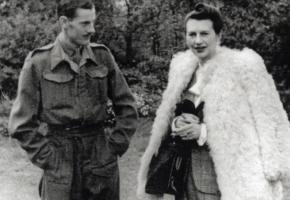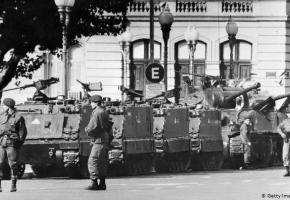Ciro Bustos was the last major survivor of Che Guevara’s famous attempt to launch a revolutionary war in Latin America, through two guerrilla movements established in Argentina and Bolivia in the 1960s. He died on New Year’s Day of 2017, aged 84, after living in exile for forty years in Malmo, Sweden, yet another victim of the wave of right-wing military dictatorships that swept over Bolivia, Chile and Argentina in the 1970s. Four years ago, Ciro published his memoirs in English with Verso (translated by Ann Wright and with an introduction by Jon Lee Anderson, the biographer of Che).
His book is a riveting account of what it was like to be caught up in the maelstrom of the Cuban Revolution in the early 1960s, and - an even more extraordinary story - to be tapped on the shoulder and asked to work on a special project with Che. This is the final vital yet forgotten element that completes the jigsaw of Che Guevara’s remarkable life, as well as the amazing story of the man who worked with him to bring the revolution to Argentina and to Latin America - and paid a heavy price for doing so, with years in prison and in exile. It is also a wonderful book to read, written with energy and humour.
Bustos was an artist, brought up and working in Mendoza, a small town in the Argentine Andes. In the early 1960s, he was attracted, moth-like, to the flame of revolution, and in April 1961 he travelled to Cuba as a volunteer; he was soon sent off to run a pottery workshop in the provincial town of Holguín. In his book, he gives a wonderful description of the utopian atmosphere in the early years of the Revolution, when inexperienced novices tried to do impossible things, hampered by the sectarianism of the Communist Party. A year later, in 1962, he was recruited by Guevara to work on his plans for a revolution in Argentina.
Bustos first came to public attention years later when he was captured in Bolivia in April 1967, together with the French writer Régis Debray, already famous. The two men had emerged from Che’s guerrilla encampment with organisational tasks to undertake in the outside world. When detained by the military in the eastern oil-town of Camiri, there were initially fears for their lives. Régis was already a well-known writer with contacts within the French political elite; he soon had secured the support of General de Gaulle, then the French president. Ciro Bustos was an unknown Argentine, armed with a pseudonym and pretending to be a naïve activist who had been invited to a political conference without knowing much about it. He looked the part, and kept a low profile.
I know, because I was there. I saw him in Camiri in August 1967 where he and Régis were still being held in prison. What I didn’t know then, something that Ciro had managed to keep secret from the Bolivian military and from his CIA interrogators over the previous months, was that he had been Che’s principal contact man in Argentina over the previous four years, responsible for liaising with local political groups in Argentina and organising supporting cadres, as well as despatching recruits to join the embryonic guerrilla army. If the authorities were to discover who Ciro really was, their torturers would soon have uncovered his contacts. This he sought to avoid at all costs, creating an image for himself as a neutral observer, neither in support of the guerrillas nor of the Bolivian army.
 Ciro Bustos (front row, left) and journalist Regis Debray (to his right), at a military tribunal in 1967. They were captured in the Bolivian jungle several months before Guevara.
Ciro Bustos (front row, left) and journalist Regis Debray (to his right), at a military tribunal in 1967. They were captured in the Bolivian jungle several months before Guevara.
When the officers in Camiri found out that Bustos was an artist, they asked him to prove it by drawing portraits of the guerrillas he had been with. This he did, and rather good they are too. Subsquently, Ciro was accused of treachery, and even of “betraying Che Guevara”, yet these accusations were wide of the mark. Sketching the faces of the guerrillas was not going to assist in their capture; the military had already captured all their passports and knew exactly who was in Guevara’s band. Bustos and Debray were also accused of betraying the presence of Che in Bolivia, yet the Bolivians and the CIA were already well aware that Che was in the country, even before the capture of the two foreigners in April 1967. The Americans had made plans for an American training camp outside Santa Cruz in the same month of April.
The extraordinary story that Bustos had kept secret went back six years. When first living in Cuba, and working as a potter in Holguín, he had inevitably fallen in with other Argentines in Cuba, notably Alberto Granados, Che’s motor-biking friend. Soon he encountered Jorge Masetti, an Argentine journalist tasked by Guevara to prepare a guerrilla camp in the north of Argentina. When all was ready, it was planned that Guevara himself – still working then as the Cuban minister of industries - would come to lead the struggle. Bustos was enrolled in the project and given the task of organising intelligence and security.
Masetti had originally gone to Cuba in 1958 to report on the revolutionary war in the Sierra Maestra for Argentine radio; subsequently he had been asked by Guevara to set up and run Cuba’s international press agency, Prensa Latina. He had also been involved in gun-running from Cuba to the FLN, the revolutionary guerrillas fighting the French in Algeria. He seemed to be the obvious man to organise Guevara’s first attempt to carry the revolutionary flame to Argentina.
 Che Guevara and Jorge Mssetti
Che Guevara and Jorge Mssetti
The details of the Masetti’s project in Argentina disclosed in Ciro’s book have never been told so clearly before, and he describes in detail the steps that were taken to set up a guerrilla base. A farm was purchased on the Bolivian side of the border and a handful of would-be guerrillas, Argentine and Cuban, were trained in Cuba. The task of Bustos was to make contact with friendly political groups in Buenos Aires and other towns, and to find potential recruits for the embryonic guerrilla force.
It was by no means plain sailing, and there was even some lack of cooperation from the Cuban state. When the first group went from Cuba to Czechoslovakia (there were no direct flights from Havana to the Latin American mainland at that time), they found themselves stuck in Prague in January 1963 with no means of getting to Bolivia or Argentina. Masetti’s solution was to fly them all to Algiers where they enjoyed a warm welcome from the new Algerian leaders, Ben Bella and Houari Boumedienne. There they continued their training before moving on in May to Sao Paulo and La Paz. Once in Bolivia, they travelled down to the farm that had been purchased close to the Argentine border.
The frontier zone consisted of thick forest that was virtually impassable, with tracks interrupted by wide rivers and high cliffs. Eventually a new base was established on the Argentine side, and Bustos was sent off to find fresh recruits in the cities. There were moments of optimism and of tragedy. New recruits were found but there were also defections and even, controversially, executions. It was a bitter and difficult tale, and Bustos’s account spares no one. At no stage were things sufficiently developed to allow Guevara to join them, and very soon it ended in disaster. Someone, though not Bustos, had recruited a couple of police spies who had infiltrated a Communist Party group in Buenos Aires. Sent up to the guerrilla camp in March 1964, the spies alerted the police on their arrival, and the guerrillas were soon flushed out. Most were captured and some disappeared, including Masetti and a companion who were never heard of again.
After this disaster, the surviving political group in Argentina that supported Bustos, made up of leftists who were neither Communists nor Peronists but were committed to the ideals of the Cuban Revolution, decided formally that there was no future for the armed struggle in Argentina. The country was deemed too large for them to copy the Cuban example. Yet when Bustos and an Argentine comrade were summoned to Havana for a post-mortem with Che in July 1964, they could not bring themselves to explain to the great and future commander of the Latin American revolution that they thought his ideas to be mistaken, certainly in the case of Argentina. Che was allowed to believe that his project was still viable and had their support. In any case, he would brook no argument. “You have to begin all over again,” he told them.
A year later, in 1965, the Argentine groups decided definitively that they could not support the strategy of armed struggle. Bustos was told to convey this information to Che in Cuba, but by this time Che had left Habana and was away fighting in the Congo. Not until April 1966 did Bustos receive a message to travel once again to Havana.

When he got there, there was no sign of Che. Maybe he was still in Prague where he had stayed for several months after the Congo expedition. Bustos was told to write a report about conditions in Argentina, but there was no one there with whom to discuss the Argentine lack of enthusiasm for the armed struggle. He was told to return home to Córdoba to await further instructions.
Then, in a bizarre interlude, Bustos was invited to China. There he was feted as a revolutionary hero from Latin America, as though he was Che himself. It was the start of the Cultural Revolution in the middle of 1966, and after a formal dinner with the Mayor of Peking, Bustos was summoned to an interview with Kuo Mo-Jo, one of the most senior leaders of the Chinese Revolution. “When you go back to your country,” he was told, “you must lead your comrades in a campaign of public denunciation of the revisionist role, in its complicity with imperialism, played by Fidel Castro, who has betrayed the revolution.”
Bustos thought he must have misheard, or perhaps the translation was not quite right. The interpreter repeated these words, and Bustos was obliged to reply: “While our project (in Argentina) is independent of the Cuban Revolution,” he said, “and our commander is Che and not Fidel Castro, for us and for all Latin Americans engaged in the revolutionary struggle, Fidel’s Cuba is the example to follow.” The interview was abruptly terminated, and Bustos was soon shepherded to the airport to return home.
Several months later, in January 1967, Che sent an emissary to meet Bustos in Córdoba. This was the famous Tania Bunke, a Cuban spy of Argentine origin who had been based for some time in Bolivia. She had a simple message for Bustos: “Che wants to see you”.
The second half of Ciro’s book deals with the Bolivian expedition, about which more is publicly known than about the earlier Masetti disaster. Ciro finally got to the guerrilla camp at Nancahuazú in March 1967 and was reunited with Che. Che told him that the strategic object of his presence in Bolivia was to seize power in Argentina.

This has long been guessed at, yet this is the first time that we have heard Bustos’s account of this seminal meeting. Che outlined his plans: “I want to enter Argentina through the area you were exploring, with two columns of about a hundred men, Argentines, in the space of no more than two years. Your work from now on will be to send them to me: I want you to coordinate what needs to be done to get the people here, the logistics of it. Try to maintain your cover as long as you can, before you are forced to join us as well.”
This was the plan, but of course it fell apart as soon as Bustos and Debray left the camp in Nancahuazú. They were captured and detained in Camiri, and subsequently sentenced to thirty years in prison. At the same time, Guevara’s guerrilla group was involved in fierce battles for survival. In October, Guevara himself was captured and executed. Bustos was amnestied in 1970 and went to live first in Chile, and then in Argentina. From each country he was ejected by the installation of a military dictatorship. Eventually, in 1976, he was granted asylum in Sweden, where he has lived ever since. His unique and original story, told at last, is a brilliant contribution to the eternally fascinating tale of the Latin American revolutionary movements of the 1960s.
Che Wants To See You, the untold story of Che Guevara, by Ciro Bustos,(translated by Ann Wright), published by Verso, 468pp, £25
Richard Gott, who reported for the Guardian in Bolivia in 1967, is the author of Guerrilla Movements in Latin America, Thomas Nelson, 1971.

















